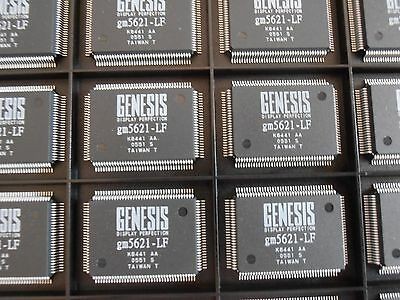GM5621-LF
Part Number: GM5621-LF
Manufacturer: STMicroelectronics
Description: STMicroelectronics Dual input LCD controller
Shipped from: Shenzhen/HK Warehouse
Stock Available: Check with us
ICRFQ.com - Electronic Components Distributor in China Since 2003

Part Number: GM5621-LF
Manufacturer: STMicroelectronics
Description: STMicroelectronics Dual input LCD controller
Shipped from: Shenzhen/HK Warehouse
Stock Available: Check with us
The Genesis GM5621 is a compact, dual-input LCD controller. Its packaging has only a few pins. They support resolutions up to WXGA /SXGA and are designed to work with LCD monitors. The GM5621, built on Genesis’s exclusive, state-of-the-art image-processing technology, is a high-quality replacement for both single- and dual-input analog monitors. The GM5621 is equipped with the brand new Instant Auto technology, which enables quick and precise image alignment for both still and moving images derived from the analog input signal. The GM5621 has an on-chip, a TCON, and an industry-standard dual-channel LVDS transmitter. The GM5626 can Both of these features are included in the GM5621.
The GM5621 also has a built-in x86 OCM with an SPI-compatible interface, a customizable coefficient scaling engine, a multicolor proportional font OSD engine, and SPI compatibility. In addition to high quality and dependability, the GM5621 gives a shallow cost system design. This is accomplished by minimizing the number of components as well as the area of the board. The GM2621 is a pin-compatible analog, the derivative device that integrates ADC and PLL; however, it does not include a DVI receiver.
Mainstream and dual-inputanalog SXGA/XGA/WXGA LCD monitors
The LCD controller is a tiny microprocessor that translates the customer’s software code (known as firmware) into LCD-understandable data. The LCD panel displays the user’s viewable graphics, characters, photos, and numbers.
Without a controller, the engineer working on the display would have to address each segment and pixel manually. This would increase the time spent programming and the money spent on development, not to mention the amount of coffee needed.
In a nutshell, the LCD controller/driver modifies the incoming signal (including resolution scaling, if necessary) and then sends the modified signal to the LCD screen. Output interfaces include Serial Peripheral Interface (SPI), Inter-Integrated Circuit (I2C), and Parallel (Pi).
You’ll find two more input/output systems on most LCD controller/driver boards. However, these are not one-way mechanisms. The on-screen menu (OSD) allows you to adjust and keep an eye on things like brightness, picture, and color. The other is exchanging data through networks like IP, Bluetooth, or Ethernet.
An inverter on the LCD board provides electricity to the LCD’s backlight. LCDs employ a cold-cathode fluorescent bulb, which requires AC electricity for power rather than the DC often used by computers. Inverters are used to convert DC power sources to AC power. However, the initial DC-to-AC conversion is still required so that the device can regulate the AC frequency driving the inverter.
LCDs typically have onboard memory, or RAM, built into the control board. This RAM stores information that the drivers can then send to the LCD module and its pixels, such as the appropriate voltage, current, and timing.
The touchscreen controller has grown in popularity alongside the proliferation of touchscreen devices. Both capacitive touchscreens and resistive touchscreens are available. They use sensors to pick up the touch signal and relay that information to the controller. The controller then executes the command on behalf of the OS.
Think about the input signals I stated before to get into the nitty-gritty. LCD technology can handle many signal types, including VGA, HDMI, DVI, and DisplayPort. Aspect ratio, screen size, display resolution, color depth, and refresh rate are a few variables defining these computer display standards. The use of analog versus digital signals is a critical differentiator between the two types of specifications.
While analog signals are continuous, digital signals are represented by discrete numbers, most commonly 0s and 1s. Most modern communication relies on digital signals because of their convenience, reliability, and low maintenance costs compared to analog transmissions, which make it impossible to filter out extraneous data. To transition to digital signals, converters are employed to swap out the analog sequence’s continuous real numbers for discrete ones and zeros sequences.
The Video Graphics Array (VGA) interface standard is widely used in analog-based computing. Over the past few years, however, high-definition multimedia interfaces (HDMI), which have become the de facto standard for digital signal transmissions, have eclipsed the VGA interface.
Audio and video are both transmitted digitally over HDMI. Common types of HDMI connections include single-link, dual-link, and micro. These connectors transmit the input signal to the LCD controller, which then decides what is displayed.
The LCD controller board converts input impulses into panel-readable output signals to show a picture and possibly audio. Although controller boards come in a wide variety of shapes and sizes, it’s usually relatively easy to install one into your computer if you pick one compatible with your hardware.
Please get in touch with ICRFQ if you have any questions concerning GM5621-LF. In China, we are the market leader for electronic components distribution. Just give us a ring, and we’ll be happy to take your call.
WhatsApp us